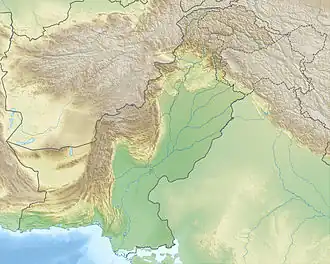Takht-e-Sulaiman
| Takht-e-Sulaiman | |
|---|---|
 Takht-e-Sulaiman | |
| Highest point | |
| Elevation | 3,487 m (11,440 ft) |
| Prominence | 1,775 m (5,823 ft) |
| Listing | List of mountains in Pakistan |
| Coordinates | 31°40′57.66″N 69°56′11.64″E / 31.6826833°N 69.9365667°E |
| Geography | |
| Location | Pakistan |
| Parent range | Sulaiman Mountains |
Takht-e-Sulaiman[a] (lit. 'Throne of Solomon') is a peak of the Sulaiman Mountains, located near the town of Darazinda in the Dera Ismail Khan Subdivision of Khyber Pakhtunkhwa, Pakistan.[1] It is close to Dera Ismail Khan Subdivision's borders with both South Waziristan and Zhob, Balochistan. At 3,487 metres (11,440 ft), it is the highest peak in Dera Ismail Khan District.[1]
In mythology
_(14580156637).jpg)
Ibn Battuta named Takht-e-Sulaiman as Kōh-e Sulaymān, "Mount of Solomon".[2] A legend, recorded by imhas it that Prophet Solomon climbed this mountain and looked out over the land of Hindustan, which was then "covered with darkness". After staying on the peak, he turned back without descending into this new frontier, and so the peak got named after him.[3]
According to the Pashtun mythology, Qais Abdur Rashid, said to be the legendary ancestor of the Pashtun people, is buried on top of Takht-e-Sulaiman, which gives the peak the local Pashto name of Da Kasī Ghar (د کسي غر, "Mountain of Qais").[4]
Tourism
Takht-e-Sulaiman is surrounded by olive groves and pine-nut (chalghoza) forests, and hosts wild animals like markhors, wolves, rabbits, eagles and partridges. Royalty from the Gulf Arab states are known to hunt precious birds in the region.[5]
References
- ^ a b "Geography: Mountains of Pakistan". Dawn. 5 September 2009. Retrieved 2 February 2018.
- ^ "Sulaiman Mountains, Pakistan". NASA Earth Observatory. 7 October 2002. Archived from the original on 4 April 2003. Retrieved 10 Nov 2013.
- ^ Qaisrani, Saad (10 September 2017). "To the throne of Sulaiman". The News International. Retrieved 2 February 2018.
- ^ McMahon, A. H. "Ascent of the Takht e Suleiman". Khyber.org. Archived from the original on 14 July 2017. Retrieved 2 February 2018.
- ^ Betini, Asad Khan (23 February 2018). "Sulaiman's throne". The Friday Times. Retrieved 28 November 2024.